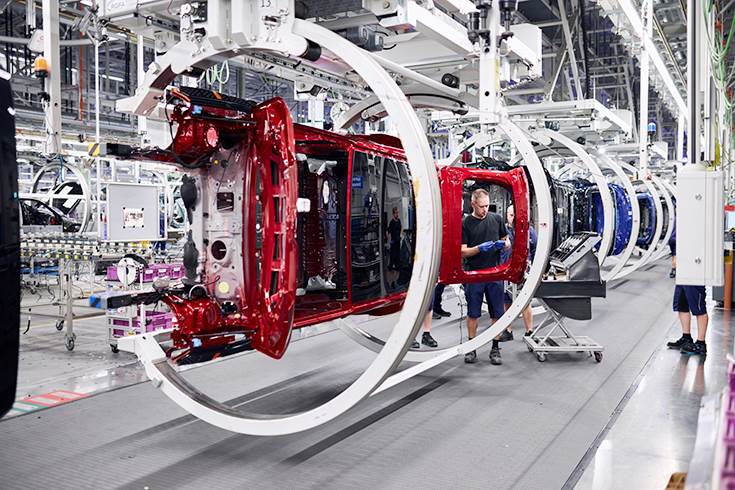Preventing unplanned stoppages before they can occur is the aim of the smart analysis system being used in assembly at BMW Group Plant Regensburg. Predictive maintenance is proactive and preventive, which is precisely what the smart monitoring system offers.
Data-driven analyses of conveying equipment allows potential faults to be identified early and avoided – thereby maintaining optimal vehicle production flow. The artificial intelligence (AI)-supported system avoids an average of around 500 minutes of disruption per year in vehicle assembly at the Regensburg plant alone.
Data analysis for faster, preventive response to potential disruptions
For assembly at BMW Group Plant Regensburg, vehicles are generally attached to mobile load carriers or skid systems, which pass through the production halls in a chain. Any technical fault in the state-of-the-art conveyor systems can bring assembly lines to a standstill – requiring more maintenance effort and thus resulting in higher costs.
To prevent this from happening, the innovation team at BMW Group Plant Regensburg has developed a system that can identify potential technical defects early – and thus avoid any lost production. The conveyor elements affected can be removed from the assembly line and repaired, away from production. The advantage is that the monitoring system does not require any additional sensors or hardware, but evaluates existing data from installed components and conveyor element control. An alarm sounds if anomalies are found.
 Assembly operations of the new BMW iX2 at the BMW Group Plant in Regensburg.
Assembly operations of the new BMW iX2 at the BMW Group Plant in Regensburg.
For example, the load carriers used to transport vehicles through assembly send various data to the carrier control system. This data is then transmitted via the carrier and plant control system to the BMW Group’s own predictive maintenance cloud platform. This is where the analysis begins: The algorithm constantly searches for irregularities, such as fluctuations in power consumption, abnormalities in conveyor movements or barcodes that are not sufficiently legible, which could trigger a malfunction. If anomalies are found, the maintenance control centre receives a warning message, which it assigns to the maintenance technician on duty. “The surveillance monitors at our control centre run 24/7,” explains project manager Oliver Mrasek. “This enables us to respond quickly to any kind of fault report and take the affected vehicle out of the cycle.”
Implementation – AI-supported, standardised and cost-effective
Predictive maintenance is not a standalone solution, stresses Mrasek. The system was standardised in collaboration with the BMW Group’s central shopfloor management and other plant sites to facilitate swift and straightforward rollout to other BMW Group plant locations around the world. This approach is also cost-effective. “We don’t need any additional sensors, so the only costs are for storage and computing power.”
Machine-learning models developed in-house were also implemented in the system, which uses so-called heatmaps with various colour codes for different abnormalities to visualise the model’s findings. “This allows us to map different fault patterns in various components and respond to them in a targeted manner,” explains Mrasek.
Based on these practical findings, the algorithms are continuously improved and refined. The team is currently in the process of connecting additional installations, optimising the system and integrating recommended actions into fault messages. The fault message could, for example, indicate similar problems that have occurred in a system. This simplifies troubleshooting for maintenance technicians – for example, if an impeller on the conveyor trolley is defective. “Optimal predictive maintenance not only saves us money, it also means we can deliver the planned quantity of vehicles on time – which saves a huge amount of stress in production,” explains Deniz Ince, the team’s data scientist.
Aiming for predictability
Mrasek and his colleagues have been working on data-driven monitoring of conveyor technology for the past six years. Today, around 80 percent of the main assembly lines are already monitored in this way.
“We can’t detect or prevent every single fault in advance, of course – but we are currently avoiding at least 500 minutes of downtime per year in vehicle assembly alone,” he explains. It is easy to calculate how much this adds up to. At BMW Group Plant Regensburg, a vehicle rolls off the assembly line roughly every minute – every 57 seconds, to be exact – and the system is already being used in conveyor systems at the plant sites in Dingolfing, Leipzig and Berlin.
The aim is to further exploit the possibilities of artificial intelligence, with the system learning to estimate how much time remains between detection of the fault and the potential stoppage. This would help technicians decide how soon they need to perform maintenance and allow them to prioritise, if needed. Mrasek also sees further potential in other areas of the plant: “We are currently testing whether we can also use the system for the equipment used to fill our vehicles with brake fluid and coolant, for example.”
